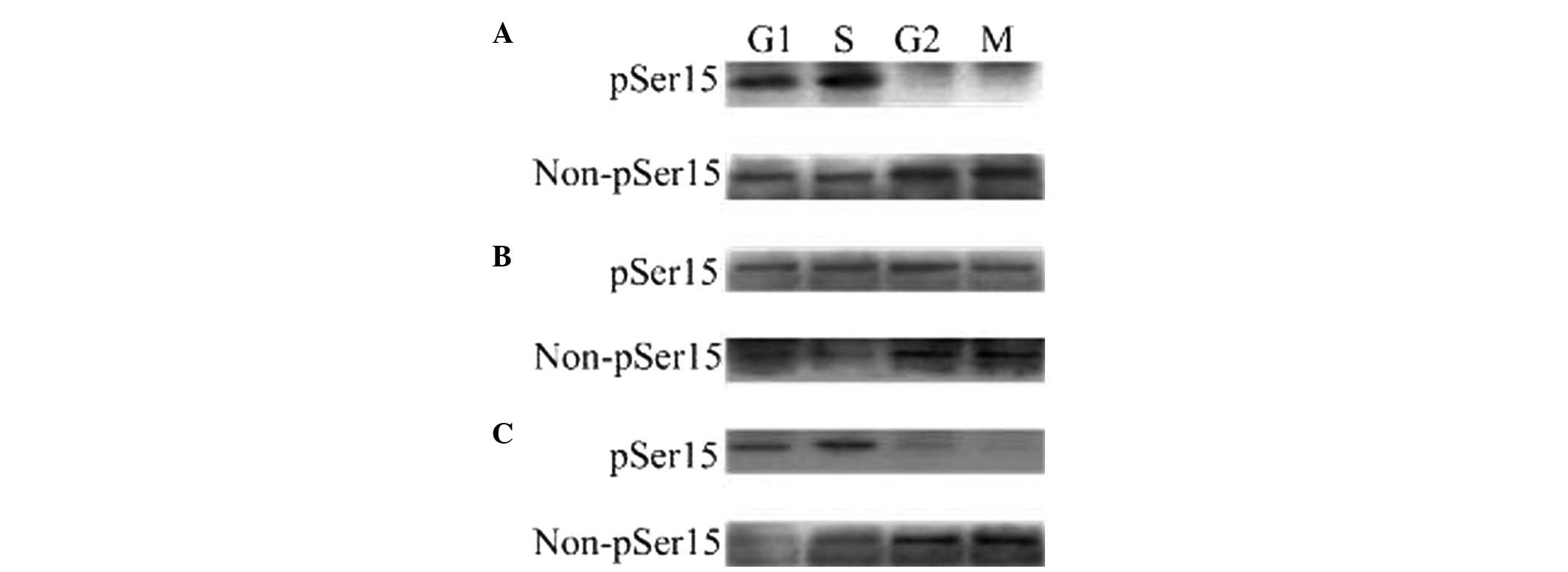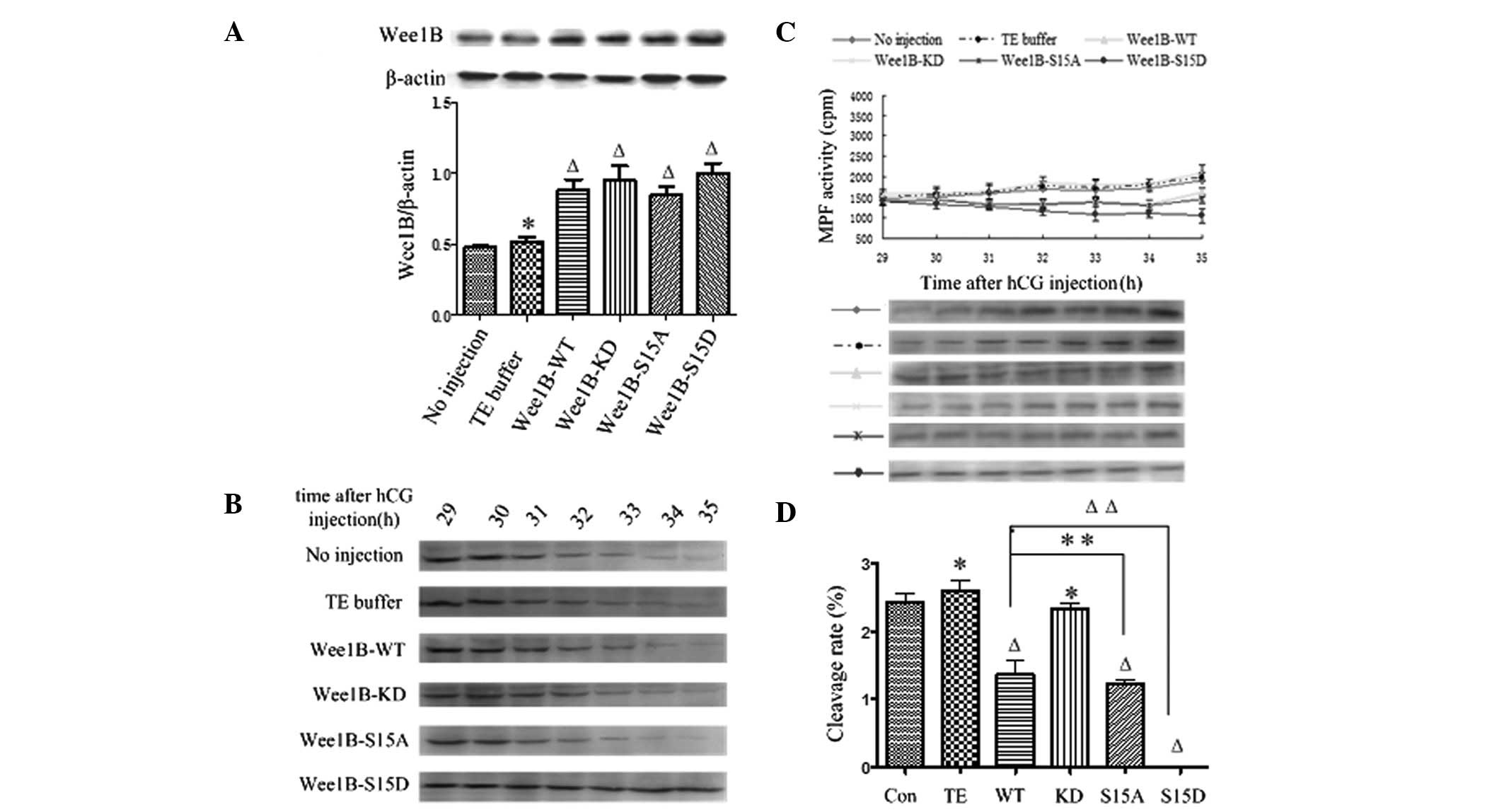|
1
|
Nigg EA: Mitotic kinases as regulators of
cell division and its checkpoints. Nat Rev Mol Cell Biol. 2:21–32.
2001. View Article : Google Scholar : PubMed/NCBI
|
|
2
|
Nurse P: Universal control mechanism
regulating onset of M-phase. Nature. 344:503–508. 1990. View Article : Google Scholar : PubMed/NCBI
|
|
3
|
Coleman TR and Dunphy WG: Cdc2 regulatory
factors. Curr Opin Cell Biol. 6:877–882. 1994. View Article : Google Scholar : PubMed/NCBI
|
|
4
|
Lew DJ and Kornbluth S: Regulatory roles
of cyclin dependent kinase phosphorylation in cell cycle control.
Curr Opin Cell Biol. 8:795–804. 1996. View Article : Google Scholar : PubMed/NCBI
|
|
5
|
Nakajima H, Yonemura S, Murata M, Nakamura
N, Piwnica-Worms H and Nishida E: Myt1 protein kinase is essential
for Golgi and ER assembly during mitotic exit. J Cell Biol.
181:89–103. 2008. View Article : Google Scholar : PubMed/NCBI
|
|
6
|
Mueller PR, Coleman TR, Kumagai A and
Dunphy WG: Myt1: a membrane-associated inhibitory kinase that
phosphorylates Cdc2 on both threonine-14 and tyrosine-15. Science.
270:86–90. 1995. View Article : Google Scholar : PubMed/NCBI
|
|
7
|
Booher RN, Deshaies RJ and Kirschner MW:
Properties of Saccharomyces cerevisiae wee1 and its
differential regulation of p34CDC28 in response to G1 and G2
cyclins. EMBO J. 12:3417–3426. 1993.
|
|
8
|
McGowan CH and Russell P: Human Wee1
kinase inhibits cell division by phosphorylating p34cdc2
exclusively on Tyr15. EMBO J. 12:75–85. 1993.PubMed/NCBI
|
|
9
|
McGowan CH and Russell P: Cell cycle
regulation of human WEE1. EMBO J. 14:2166–2175. 1995.PubMed/NCBI
|
|
10
|
Mueller PR, Coleman TR and Dunphy WG: Cell
cycle regulation of a Xenopus Wee1-like kinase. Mol Biol
Cell. 6:119–134. 1995. View Article : Google Scholar
|
|
11
|
Kornbluth S, Sebastian B, Hunter T and
Newport J: Membrane localization of the kinase which phosphorylates
p34cdc2 on threonine 14. Mol Biol Cell. 5:273–282. 1994. View Article : Google Scholar : PubMed/NCBI
|
|
12
|
Booher RN, Holman PS and Fattaey A: Human
Myt1 is a cell cycle-regulated kinase that inhibits Cdc2 but not
Cdk2 activity. J Biol Chem. 272:22300–22306. 1997. View Article : Google Scholar : PubMed/NCBI
|
|
13
|
Liu F, Stanton JJ, Wu Z and Piwnica-Worms
H: The human Myt1 kinase preferentially phosphorylates Cdc2 on
threonine 14 and localizes to the endoplasmic reticulum and Golgi
complex. Mol Cell Biol. 17:571–583. 1997.PubMed/NCBI
|
|
14
|
Liu F, Rothblum-Oviatt C, Ryan CE and
Piwnica-Worms H: Overproduction of human Myt1 kinase induces a G2
cell cycle delay by interfering with the intracellular trafficking
of Cdc2-cyclin B1 complexes. Mol Cell Biol. 19:5113–5123.
1999.PubMed/NCBI
|
|
15
|
Wells NJ, Watanabe N, Tokusumi T, Jiang W,
Verdecia MA and Hunter T: The C-terminal domain of the Cdc2
inhibitory kinase Myt1 interacts with Cdc2 complexes and is
required for inhibition of G(2)/M progression. J Cell Sci. 112(Pt
19): 3361–3371. 1999.PubMed/NCBI
|
|
16
|
Hanna CB, Yao S, Patta MC, Jensen JT and
Wu X: WEE2 is an oocyte-specific meiosis inhibitor in rhesus
macaque monkeys. Biol Reprod. 82:1190–1197. 2010. View Article : Google Scholar : PubMed/NCBI
|
|
17
|
Shimaoka T, Nishimura T, Kano K and Naito
K: Critical effect of pigWee1B on the regulation of meiotic
resumption in porcine immature oocytes. Cell Cycle. 8:2375–2384.
2009. View Article : Google Scholar : PubMed/NCBI
|
|
18
|
Nakanishi M, Ando H, Watanabe N, et al:
Identification and characterization of human Wee1B, a new member of
the Wee1 family of Cdk-inhibitory kinases. Genes Cells. 5:839–847.
2000. View Article : Google Scholar : PubMed/NCBI
|
|
19
|
Nishimura T, Shimaoka T, Kano K and Naito
K: Insufficient amount of Cdc2 and continuous activation of Wee1 B
are the cause of meiotic failure in porcine growing oocytes. J
Reprod Dev. 55:553–557. 2009. View Article : Google Scholar : PubMed/NCBI
|
|
20
|
Han SJ and Conti M: New pathways from PKA
to the Cdc2/cyclin B complex in oocytes: Wee1B as a potential PKA
substrate. Cell Cycle. 5:227–231. 2006. View Article : Google Scholar : PubMed/NCBI
|
|
21
|
Han SJ, Chen R, Paronetto MP and Conti M:
Wee1B is an oocyte-specific kinase involved in the control of
meiotic arrest in the mouse. Curr Biol. 15:1670–1676. 2005.
View Article : Google Scholar : PubMed/NCBI
|
|
22
|
Mueller PR and Leise WF 3rd: Measurement
of Wee kinase activity. Methods Mol Biol. 296:299–328.
2005.PubMed/NCBI
|
|
23
|
Islam MS, Kawase O, Hase S, Hoshi M and
Matsumoto M: PKA activation in concert with ARIS and asterosap
induces the acrosome reaction in starfish. Zygote. 14:329–340.
2006. View Article : Google Scholar : PubMed/NCBI
|
|
24
|
Wang J and Liu XJ: Progesterone inhibits
protein kinase A (PKA) in Xenopus oocytes: demonstration of
endogenous PKA activities using an expressed substrate. J Cell Sci.
117:5107–5116. 2004.PubMed/NCBI
|
|
25
|
Pirino G, Wescott MP and Donovan PJ:
Protein kinase A regulates resumption of meiosis by phosphorylation
of Cdc25B in mammalian oocytes. Cell Cycle. 8:665–670. 2009.
View Article : Google Scholar : PubMed/NCBI
|
|
26
|
Kovo M, Kandli-Cohen M, Ben-Haim M,
Galiani D, Carr DW and Dekel N: An active protein kinase A (PKA) is
involved in meiotic arrest of rat growing oocytes. Reproduction.
132:33–43. 2006. View Article : Google Scholar : PubMed/NCBI
|
|
27
|
Xiao J, Liu C, Hou J, et al: Ser149 is
another potential PKA phosphorylation target of Cdc25B in G2/M
transition of fertilized mouse eggs. J Biol Chem. 286:10356–10366.
2011. View Article : Google Scholar : PubMed/NCBI
|
|
28
|
Schultz R: PKA and CDC25B: at last
connected. Cell Cycle. 8:516–517. 2009. View Article : Google Scholar : PubMed/NCBI
|
|
29
|
Zhang Y, Zhang Z, Xu XY, et al: Protein
kinase A modulates Cdc25B activity during meiotic resumption of
mouse oocytes. Dev Dyn. 237:3777–3786. 2008. View Article : Google Scholar : PubMed/NCBI
|
|
30
|
Okamoto K and Sagata N: Mechanism for
inactivation of the mitotic inhibitory kinase Wee1 at M phase. Proc
Natl Acad Sci USA. 104:3753–3758. 2007. View Article : Google Scholar : PubMed/NCBI
|
|
31
|
Burrows AE, Sceurman BK, Kosinski ME, et
al: The C. elegans Myt1 ortholog is required for the proper
timing of oocyte maturation. Development. 133:697–709. 2006.
|
|
32
|
Maller JL, Butcher FR and Krebs EG: Early
effect of progesterone on levels of cyclic adenosine
3′:5′-monophosphate in Xenopus oocytes. J Biol Chem.
254:579–582. 1979.
|
|
33
|
Conti M, Andersen CB, Richard FJ,
Shitsukawa K and Tsafriri A: Role of cyclic nucleotide
phosphodiesterases in resumption of meiosis. Mol Cell Endocrinol.
145:9–14. 1998.PubMed/NCBI
|
|
34
|
Conti M, Andersen CB, Richard F, et al:
Role of cyclic nucleotide signaling in oocyte maturation. Mol Cell
Endocrinol. 187:153–159. 2002. View Article : Google Scholar : PubMed/NCBI
|
|
35
|
Dekel N: Protein
phosphorylation/dephosphorylation in the meiotic cell cycle of
mammalian oocytes. Rev Reprod. 1:82–88. 1996. View Article : Google Scholar : PubMed/NCBI
|
|
36
|
Okamoto K, Nakajo N and Sagata N: The
existence of two distinct Wee1 isoforms in Xenopus:
implications for the developmental regulation of the cell cycle.
EMBO J. 21:2472–2484. 2002. View Article : Google Scholar : PubMed/NCBI
|
|
37
|
Parker LL and Piwnica-Worms H:
Inactivation of the p34cdc2-cyclin B complex by the human WEE1
tyrosine kinase. Science. 257:1955–1957. 1992. View Article : Google Scholar : PubMed/NCBI
|
|
38
|
Hogan B, Beddington R, Constantini F and
Lacy E: Manipulating the mouse embryo: a laboratory manual. Cold
Harbor Laboratory Press; New York: 1986
|
|
39
|
Zhang Z, Su WH, Feng C, et al: Polo-like
kinase 1 may regulate G2/M transition of mouse fertilized eggs by
means of inhibiting the phosphorylation of Tyr 15 of Cdc2. Mol
Reprod Dev. 74:1247–1254. 2007. View Article : Google Scholar : PubMed/NCBI
|
|
40
|
Cui C, Zhao H, Zhang Z, et al: CDC25B acts
as a potential target of PRKACA in fertilized mouse eggs. Biol
Reprod. 79:991–998. 2008. View Article : Google Scholar : PubMed/NCBI
|
|
41
|
Gallicano GI, McGaughey RW and Capco DG:
Activation of protein kinase C after fertilization is required for
remodeling the mouse egg into the zygote. Mol Reprod Dev.
46:587–601. 1997. View Article : Google Scholar : PubMed/NCBI
|
|
42
|
Xu XY, Zhang Z, Su WH, et al: Involvement
of the p110 alpha isoform of PI3K in early development of mouse
embryos. Mol Reprod Dev. 76:389–398. 2009. View Article : Google Scholar : PubMed/NCBI
|
|
43
|
Vitolo OV, Sant'Angelo A, Costanzo V,
Battaglia F, Arancio O and Shelanski M: Amyloid β-peptide
inhibition of the PKA/CREB pathway and long-term potentiation:
reversibility by drugs that enhance cAMP signaling. Proc Natl Acad
Sci USA. 99:13217–13221. 2002.
|
|
44
|
Yamada T, Matsuda K and Uchiyama M: Atrial
natriuretic peptide and cGMP activate sodium transport through
PKA-dependent pathway in the urinary bladder of the Japanese tree
frog. J Comp Physiol B. 176:203–212. 2006. View Article : Google Scholar : PubMed/NCBI
|
|
45
|
Shimaoka T, Nishimura T, Kano K and Naito
K: Analyses of the regulatory mechanism of porcine WEE1B: the
phosphorylation sites of porcine WEE1B and mouse WEE1B are
different. J Reprod Dev. 57:223–228. 2010. View Article : Google Scholar : PubMed/NCBI
|
|
46
|
Yu B, Wang Y, Liu Y, et al: Protein kinase
A regulates cell cycle progression of mouse fertilized eggs by
means of MPF. Dev Dyn. 232:98–105. 2005. View Article : Google Scholar : PubMed/NCBI
|
|
47
|
Oh JS, Han SJ and Conti M: Wee1B, Myt1,
and Cdc25 function in distinct compartments of the mouse oocyte to
control meiotic resumption. J Cell Biol. 188:199–207. 2010.
View Article : Google Scholar : PubMed/NCBI
|













